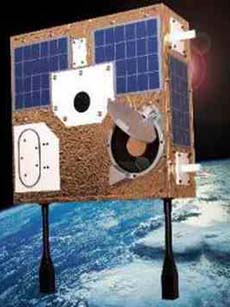Satellites hunt for dangerous objects
The Canadian Space Agency is preparing to launch a tiny satellite in 2009 to hunt down dangerous asteroids in orbit near the earth.

NEOSSat has the same design as the MOST satellite, also of Canada, launched in 2003. (Photo: University of British Columbia)
This will be Canada's first space mission to contribute to the discovery and monitoring of future cosmic objects. The Canadian Space Agency said that building and launching NEOSSat into space costs only 10 million USD.
Named NEOSSat (satellite surveying objects near the earth), the satellite is about the size of a briefcase, weighs 60 kg, and is equipped with a very small diameter telescope, only 15 cm.
Two scientists responsible for the NEOSSat program are Alan Hildebrand of Calgary University and Brad Wallace of Canada Defense Research and Development Agency. This program has funding from the Canadian Ministry of Defense.
Canadian experts say this is the first time they have used space telescopes to explore objects near the earth (NEO) that ground monitoring stations can hardly observe. When operating above the atmosphere, NEOSSat will clearly see such objects and be able to record at least 50% of objects more than 1 km in diameter.
Currently, astronomers have discovered more than 5,000 NEO. If hitting the earth, a meteorite, asteroid or comet can cause enormous catastrophes - as is the case of a 10-kilometer asteroid that is thought to have caused extinction of dinosaurs This is 65 million years.
Not only is the mission to hunt for dangerous NEOs, NEOSSat is also used by the Canadian Ministry of Defense to test the ability to use satellites to track the activity of other satellites in orbit. Currently, this work is done mainly by ground-based telescopes, but the effect is limited by cloud cover and other obstacles.
- NASA continues to hunt for dangerous meteors
- 7 fastest objects humanity ever built
- Study the impact impact of satellites on meteorites
- More than 200,000 stars appeared in NASA photos
- Our survival is threatened by these dangerous objects
- Video: Jupiter-sized UFO glides through the Sun.
- Concerned that the satellite
- Treasure hunt in the
- US develops technology to detect dangerous objects
- The Truong Chinh 4C missile warhead is an unidentified flying object
- Special objects have been put into space
- Vietnam satellite will enter space in 2018
 Van Allen's belt and evidence that the Apollo 11 mission to the Moon was myth
Van Allen's belt and evidence that the Apollo 11 mission to the Moon was myth The levels of civilization in the universe (Kardashev scale)
The levels of civilization in the universe (Kardashev scale) Today Mars, the sun and the Earth are aligned
Today Mars, the sun and the Earth are aligned The Amazon owner announced a secret plan to build a space base for thousands of people
The Amazon owner announced a secret plan to build a space base for thousands of people